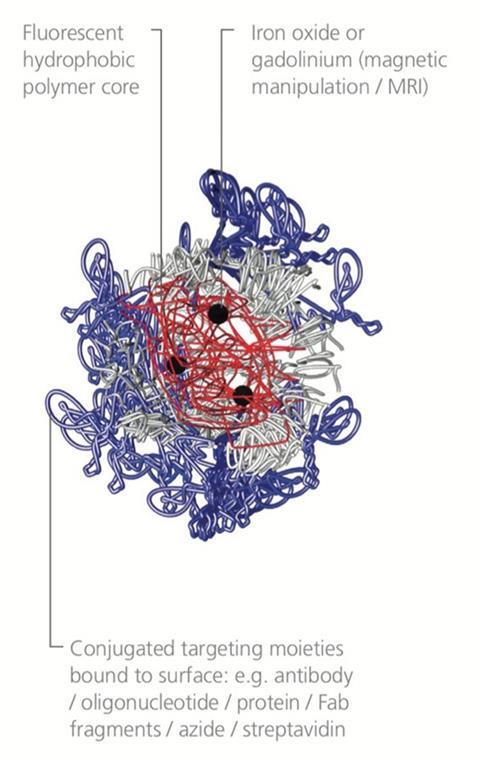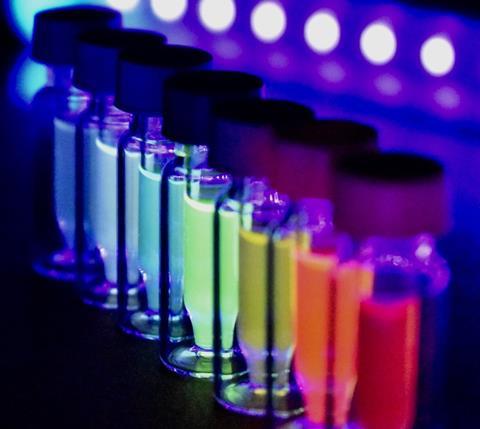The UN’s 17 sustainable development goals (SDGs) aim to create a better and more sustainable world. SDG 3 specifically focuses on good health and wellbeing for all people around the world and sets 13 quantifiable targets for 2030. These range from reduced substance abuse and a reduction in road traffic-related deaths to improved access to physical and mental healthcare. Progress towards these 13 targets will require multidisciplinary efforts that span economic, legislative and social change, but also scientific innovation to improve the way we prevent, detect and treat illnesses. In particular, targets 3.3 and 3.4 focus on preventing deaths from communicable and non-communicable diseases respectively – areas in which novel technology and techniques could make a great impact.
Conjugated polymer nanoparticles (CPNs) are innovative, highly fluorescent molecular probes with a range of potential applications that could help address current healthcare challenges. Invented in the research labs of Kings College London, UK, and developed to full commercial scale by Stream Bio, CPNs sit at the interface of chemistry, biology and physics. The photonic properties of their polymer core give them intense fluorescence spanning the visible and infrared spectrum, and the outer shell of each CPN is decorated with biomolecules that can be designed to bind to a range of target biomarkers. These properties make CPNs well suited for many biological applications, a number of which are currently being explored, and can help to drive progress towards the targets of SDG 3.

Lateral flow diagnostics for rapid, point-of-care screening
A crucial aspect of preventing premature mortality from communicable diseases, such as Covid-19, and non-communicable diseases such as cancer or cardiovascular disease (as outlined in targets 3.3 and 3.4 respectively) is early diagnosis. By developing rapid, reliable and minimally invasive point-of-care diagnostic techniques, the process of identifying diseases can be accelerated and made more accessible, helping to diagnose patients at an earlier stage. This will enable earlier intervention and result in vastly improved outcomes for patients.
Lateral flow tests (LFTs) already play a vital role in the detection of a wide variety of diseases and are well-known thanks to their widespread use for at-home Covid-19 testing. The rapid nature of LFTs, combined with their simple ‘yes/no’ result and no requirement for a lab or scientific equipment, make them ideal point-of-care tests. Enhancing existing lateral flow technology could allow for the development of more sensitive, informative and reliable LFTs that can be used to rapidly and simply screen for diseases ranging from infections to heart attacks or even cancer. Making these highly sensitive tests available at the point of care, or for at-home self-testing, is more beneficial to patients and could help to improve uptake.
Nanotechnology can drive improvements in both environmental monitoring, medical research techniques and many other areas
CPNs can enhance LFTs in a number of ways. Compared to conventional labels used in LFTs, CPNs provide a significantly higher contrast and enhanced visibility at the test line and are available in a wide range of colours. They are also more absorbent and therefore more sensitive than the gold nanoparticles typically used in LFTs. This means multi-coloured and multiplexed tests are possible with CPNs. Further, the intense fluorescence of CPNs means an improved detection limit can be attained. Stream Bio has enhanced this sensitivity further with the use of a handheld, quantifiable fluorometric reader – developed as part of a collaboration with Stream Bio’s partner – that can detect test lines more accurately than the naked eye. Preliminary studies using this technology to detect Covid-19 have demonstrated that it could provide a comparable limit of detection to lab-based PCR methods and even provide quantitative results.
CPNs are currently being investigated in a range of lateral flow applications thanks to their potential to employ various targeting molecules – such as antibodies, aptamers, affimers and molecular imprinted polymers – which have a high affinity for specific biomarkers. For example, by targeting bowel cancer biomarkers such as anti-carcinoembryonic antigen (CEA) CA199 and CA724, CPNs in a multiplexed test can label bowel cancer cells, suggesting their potential for use in a bowel cancer LFT. Ultimately this has the potential to replace the conventional, poorly subscribed, at-home screening methods currently part of age-related routine health checks. Another example is a highly sensitive LFT test for the biomarker troponin – an indicator of heart attacks. This could replace the current time-consuming lab-based methods used in emergency care environments to detect myocardial infarction, streamlining the triage process for potential heart attack patients by quickly identifying urgent cases for priority.
These are just two examples of the many ways that advanced, highly sensitive LFTs and fluorometric readers could improve overall healthcare and benefit patients.

In vivo imaging to advance medical research and techniques
Beyond in vitro diagnostic techniques such as lateral flow, in vivo imaging can be used not only in diagnostics, but also in medical research, drug development and more. Techniques such as bioluminescence imaging (BLI), fluorescence imaging (FI) and magnetic resonance imaging (MRI) can be used to study processes at a cellular level. This can provide insight into areas including cancer research and stem cell tracking, paving the way to more effective treatments for life-threatening diseases.
Cell tracking is a key technique used in the study of signalling pathways, drug discovery and developmental biology. It shows researchers how cells — including cancer or stem cells — interact and differentiate, as well as revealing their survival and migratory capabilities, which can inform the development of regenerative medicine such as cell-based therapies. This is an area that Stream Bio is currently investigating in collaboration with the University of Liverpool, UK.
Advanced therapeutic approaches such as these could enable regrowth and repair of damaged organs or tissues, helping patients to fight disease or alleviating a patient’s symptoms. In addition, cell tracking can be used to study apoptosis (cell death), which has applications in exploring the toxicological effects of drug compounds. Using powerful fluorophores such as CPNs in these types of studies has the potential to improve in vivo imaging capability, providing further insight into cell activity. By using dual labelling with a contrasting agent, CPNs can also be used to track single cells, both in two and three dimensions, which could be particularly valuable in the study of cancer. Enhanced imaging capabilities could help to drive these areas of research forward, aiding in the development of life-saving therapies.
Fluorescent labels can be used to visualise the way food passes through an organism
In vivo imaging can also be used in surgical approaches. Fluorescence-guided surgery, which involves demarcating the boundaries of a tumour with fluorophores, is becoming increasingly common, particularly for cancer treatment. This method allows for more precise surgery, sparing as much healthy tissue as possible to maximise the patient’s chances of recovery. Using CPNs as surgical fluorophores could improve the technique with better contrast and enhanced imaging capability compared to the currently used indocyanine green (ICG), and is another application being investigated as part of the collaboration with the University of Liverpool.
A further application for in vivo imaging that can help to advance healthcare is in food intake studies. Fluorescent labels can be used to visualise the way food passes through an organism to study how nutrition affects metabolism, ageing and disease, as well as in drug delivery research. Incorporating CPNs into these in vivo imaging techniques can make them more useful in research and medicine, ultimately benefitting patients through providing better, more effective treatments.
Water monitoring to limit the spread of waterborne disease
The same technological principles could also be used to tackle the effects of environmental factors on health. SDG 3.3 pertains to ending epidemics and tackling communicable illnesses, including waterborne diseases, and it is well known that access to safe, clean water can improve the overall health of a population. While infrastructure plays an important part in providing clean water to all, water monitoring technology to detect the presence, or even the absence, of pathogens or harmful substances can provide additional and immediate safety measures for drinking water.
Working in collaboration with Chelsea Technologies, Stream Bio is investigating the use of CPNs, coupled with the handheld fluorometric reader mentioned above, for environmental monitoring. The capability of CPNs to produce bright, robust fluorescent signals that are not affected by environmental conditions makes them well-suited for a variety of environmental tests, while the rapid and portable nature of the reader removes the need for labs or expensive equipment. The current focus for this application is in detecting Escherichia coli in water samples, a bacterium that can cause gastrointestinal problems and in severe infections, kidney failure. Looking to the future, Stream Bio’s technology could be applied to detect a range of water contaminants, helping to ensure safer drinking water for all.
A brighter future for health and wellbeing
Innovative technology has an important role to play in improving global health. Progress towards SDG 3 will need to draw on innovation from multiple industries and stakeholders to effect change that benefits the health of the entire population. CPNs have the potential to play a significant role in achieving this objective, from enabling earlier diagnosis and guiding treatment, to aiding in the management of environmental risk factors. With the brightness given by their structural properties, CPNs can enhance diagnostic and imaging techniques in vital health and wellbeing areas, including water monitoring, accessible and less invasive diagnostics, medical research and surgery. With healthcare a core focus for Stream Bio, further developing these applications will open new avenues in which its nanotechnology can drive improvements in both environmental monitoring, medical research techniques and many other areas. It will be exciting to see the role a spectrum-spanning range of nanoparticles will play.













No comments yet